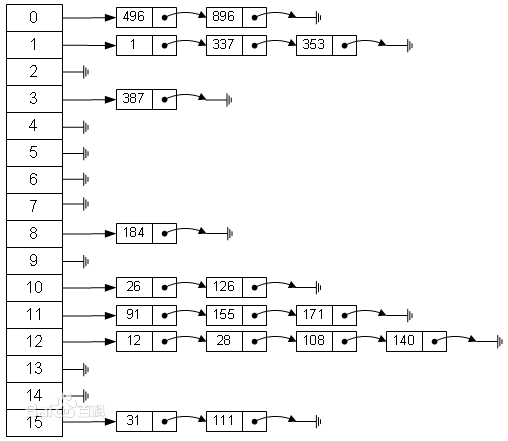hashMap数据结构图:

HashMap特点:
- 允许一个记录的键为null;
-
允许多条记录的值为null;
-
非线程安全,任意时刻多线程操作hashmap,有可能导致数据不一致,可以通过Collections的synchronizedMap来实现Map的线程安全或者使用concurrentHashMap。
HashMap是链表+数组结构组成,底层是数组,数组元素是单向链表。当产生hash碰撞事件,意味着一个位置插入多个元素,这个时候数组上面就会产生链表。
通过hashcode的高16位实现的,能保证数组table的length比较小的时候,保证高低bit都参与到hash计算中,不会有大的开销。
static final int hash(Object key) { int h; // h = key.hashCode() 为第一步 取hashCode值 // h ^ (h >>> 16) 为第二步 高位参与运算 return (key == null) ? 0 : (h = key.hashCode()) ^ (h >>> 16); }
根据key的hash值进行value内容的查找
public V get(Object key) { Node<K,V> e; return (e = getNode(hash(key), key)) == null ? null : e.value; }
final Node<K,V> getNode(int hash, Object key) { Node<K,V>[] tab; Node<K,V> first, e; int n; K k; if ((tab = table) != null && (n = tab.length) > 0 && (first = tab[(n - 1) & hash]) != null) { if (first.hash == hash && // always check first node ((k = first.key) == key || (key != null && key.equals(k)))) return first; if ((e = first.next) != null) { if (first instanceof TreeNode) return ((TreeNode<K,V>)first).getTreeNode(hash, key); do { if (e.hash == hash && ((k = e.key) == key || (key != null && key.equals(k)))) return e; } while ((e = e.next) != null); } } return null; }
put实现:
对key的hashCode()进行hashing,并计算下标( n-1 & hash),判断该位置元素是否存在,不存在,创建Node元素,存在产生碰撞,则利用key.equals()方法去链表或树中去查找对应的节点。
public V put(K key, V value) { return putVal(hash(key), key, value, false, true); }
final V putVal(int hash, K key, V value, boolean onlyIfAbsent, boolean evict) { //tab数组,p每个桶 Node<K,V>[] tab; Node<K,V> p; int n, i; //tab为空创建tab if ((tab = table) == null || (n = tab.length) == 0) //resize进行扩容 n = (tab = resize()).length; //index = (n - 1) & hash 下表位置 if ((p = tab[i = (n - 1) & hash]) == null) //创建一个新的Node元素 tab[i] = newNode(hash, key, value, null); else { //指定位置已经有元素,也就是说产生hash碰撞 Node<K,V> e; K k; //判断节点是否存在,覆盖原来原来的value if (p.hash == hash && ((k = p.key) == key || (key != null && key.equals(k)))) e = p; else if (p instanceof TreeNode) //判断是否是红黑树 //是红黑树 e = ((TreeNode<K,V>)p).putTreeVal(this, tab, hash, key, value); else { //不是红黑树,遍历链表准备插入 for (int binCount = 0; ; ++binCount) { if ((e = p.next) == null) { //尾插法添加元素 p.next = newNode(hash, key, value, null); //TREEIFY_THRESHOLD默认为8,大于8,转换为红黑树 if (binCount >= TREEIFY_THRESHOLD - 1) // -1 for 1st //如果达到这个阈值转为红黑树 treeifyBin(tab, hash); break; } //如果节点key存在,则覆盖原来位置的key if (e.hash == hash && ((k = e.key) == key || (key != null && key.equals(k)))) break; p = e; } } //检查e是否存在相应的key,如果存在就更新value,并且返回 if (e != null) { // existing mapping for key V oldValue = e.value; if (!onlyIfAbsent || oldValue == null) e.value = value; afterNodeAccess(e); return oldValue; } } ++modCount; //判断hashmap是否需要resize扩容 if (++size > threshold) resize(); //留给子类LinkedHashMap来实现的 afterNodeInsertion(evict); return null; }
resize实现:HashMap扩容实现:使用一个新的数组代替已有的容量小的数组。
final Node<K,V>[] resize() { Node<K,V>[] oldTab = table; //创建一个oldTab数组用于保存之前的数组 int oldCap = (oldTab == null) ? 0 : oldTab.length; //获取原来数组的长度 int oldThr = threshold; //原来数组扩容的临界值 int newCap, newThr = 0; if (oldCap > 0) { if (oldCap >= MAXIMUM_CAPACITY) { //如果原来的数组长度大于最大值(2^30) threshold = Integer.MAX_VALUE; //扩容临界值提高到正无穷 return oldTab; //返回原来的数组,也就是系统已经管不了了,随便你怎么玩吧 } //else if((新数组newCap)长度乘2) < 最大值(2^30) && (原来的数组长度)>= 初始长度(2^4)) //这个else if 中实际上就是咋判断新数组(此时刚创建还为空)和老数组的长度合法性,同时交代了, //我们扩容是以2^1为单位扩容的。下面的newThr(新数组的扩容临界值)一样,在原有临界值的基础上扩2^1 else if ((newCap = oldCap << 1) < MAXIMUM_CAPACITY && oldCap >= DEFAULT_INITIAL_CAPACITY) newThr = oldThr << 1; // double threshold } else if (oldThr > 0) newCap = oldThr; //新数组的初始容量设置为老数组扩容的临界值 else { // 否则 oldThr == 0,零初始阈值表示使用默认值 newCap = DEFAULT_INITIAL_CAPACITY; //新数组初始容量设置为默认值 newThr = (int)(DEFAULT_LOAD_FACTOR * DEFAULT_INITIAL_CAPACITY); //计算默认容量下的阈值 } if (newThr == 0) { //如果newThr == 0,说明为上面 else if (oldThr > 0) //的情况(其他两种情况都对newThr的值做了改变),此时newCap = oldThr; float ft = (float)newCap * loadFactor; //ft为临时变量,用于判断阈值的合法性 newThr = (newCap < MAXIMUM_CAPACITY && ft < (float)MAXIMUM_CAPACITY ? (int)ft : Integer.MAX_VALUE); //计算新的阈值 } threshold = newThr; //改变threshold值为新的阈值 @SuppressWarnings({"rawtypes","unchecked"}) Node<K,V>[] newTab = (Node<K,V>[])new Node[newCap]; table = newTab; //改变table全局变量为,扩容后的newTable if (oldTab != null) { for (int j = 0; j < oldCap; ++j) { //遍历数组,将老数组(或者原来的桶)迁移到新的数组(新的桶)中 Node<K,V> e; if ((e = oldTab[j]) != null) { //新建一个Node<K,V>类对象,用它来遍历整个数组 oldTab[j] = null; if (e.next == null) //将e也就是oldTab[j]放入newTab中e.hash & (newCap - 1)的位置, newTab[e.hash & (newCap - 1)] = e; //这个我们之前讲过,是一个取模操作 else if (e instanceof TreeNode) //如果e已经是一个红黑树的元素,这个我们不展开讲 ((TreeNode<K,V>)e).split(this, newTab, j, oldCap); else { //命名两组对象 Node<K,V> loHead = null, loTail = null; Node<K,V> hiHead = null, hiTail = null; Node<K,V> next; do { next = e.next; if ((e.hash & oldCap) == 0) { if (loTail == null) loHead = e; else loTail.next = e; loTail = e; } else { if (hiTail == null) hiHead = e; else hiTail.next = e; hiTail = e; } } while ((e = next) != null); if (loTail != null) { loTail.next = null; newTab[j] = loHead; } if (hiTail != null) { hiTail.next = null; newTab[j + oldCap] = hiHead; } } } } } return newTab; }
工作原理总结:
通过hash的方法,通过put和get存储和获取对象。存储对象时,我们将K/V传给put方法时,它调用hashCode计算hash从而得到bucket位置,进一步存储,HashMap会根据当前bucket的占用情况自动调整容量(超过Load Facotr则resize为原来的2倍)。获取对象时,我们将K传给get,它调用hashCode计算hash从而得到bucket位置,并进一步调用equals()方法确定键值对。如果发生碰撞的时候,Hashmap通过链表将产生碰撞冲突的元素组织起来,在Java 8中,如果一个bucket中碰撞冲突的元素超过某个限制(默认是8),则使用红黑树来替换链表,从而提高速度。